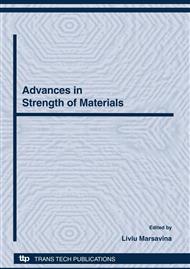[1]
Williams ML : On the stress distribution at the base of stationary crack. ASME J Appl Mech; 24 , 109-14 (1957).
Google Scholar
[2]
Rice JR. : Limitations to the-scale yielding approximation for crack-tip plasticity. J. Mech. Solids, 22, 17-26 (1974).
DOI: 10.1016/0022-5096(74)90010-6
Google Scholar
[3]
Larsson, S. G and Carlsson, A.J.: Influence of non-singular stress terms and specimen geometry on small-scale yielding at crack tips in elastic-plastic materials. J. Mech. Phys. Solids 21, 263-278 (1973).
DOI: 10.1016/0022-5096(73)90024-0
Google Scholar
[4]
Leevers PS, Radon JC : Inherent stress biaxiality in various fracture specimen geometries. Int. J. Fract. 19, 311-25 (1982).
DOI: 10.1007/bf00012486
Google Scholar
[5]
Chao, Y.J. and Zhang, X.: Constraint effect in brittle fracture. 27th National Symposium on Fatigue and fracture, ASTM STP 1296, R.S. Piascik, J.C. Newman, Jr. and D.E. Dowling, Eds., American Society for Testing and Materials, Philadelphia, pp.41-60 (1997).
DOI: 10.1520/stp16227s
Google Scholar
[6]
Chao, Y.J., Liu, S., and Broviak, B.J. : Variation of fracture toughness with constraint of PMMA specimens. Proceedings of ASME-PVP conference 393, 113-120 (1999).
Google Scholar
[7]
Chao , Y.J., Liu, S., and Broviak, B.J.: Brittle fracture: variation of fracture toughness with constraint and crack curving under mode I conditions. Experimental Mechanics 41(3), 232-241 (2001).
DOI: 10.1007/bf02323139
Google Scholar
[8]
Du ZZ, Hancock JW : The effect of non-singular stresses on crack tip constraint. J Mech Phys Solids. 39; 555-67 (1991).
Google Scholar
[9]
Yang, B. Ravi-Chandar, K.: Evaluation of elastic T-stress by the stress difference method. Engng Fract Mech. 64; 589-605 (1999).
DOI: 10.1016/s0013-7944(99)00082-x
Google Scholar
[10]
Leevers PS, Radon JC : Inherent stress biaxiality in various fracture specimen geometries. Int. J. Fract. 19, 311-25 (1982).
DOI: 10.1007/bf00012486
Google Scholar
[11]
Pluvinage G. : Fracture and Fatigue Emanating from Stress Concentrators, Kluwer Publisher (2003).
Google Scholar
[12]
Rousserie S : L"amorçage de la fissuration des pipelines en milieu bicarboné à ph neutre. Thèse présentée à l"université de Bordeaux I (2000).
Google Scholar


